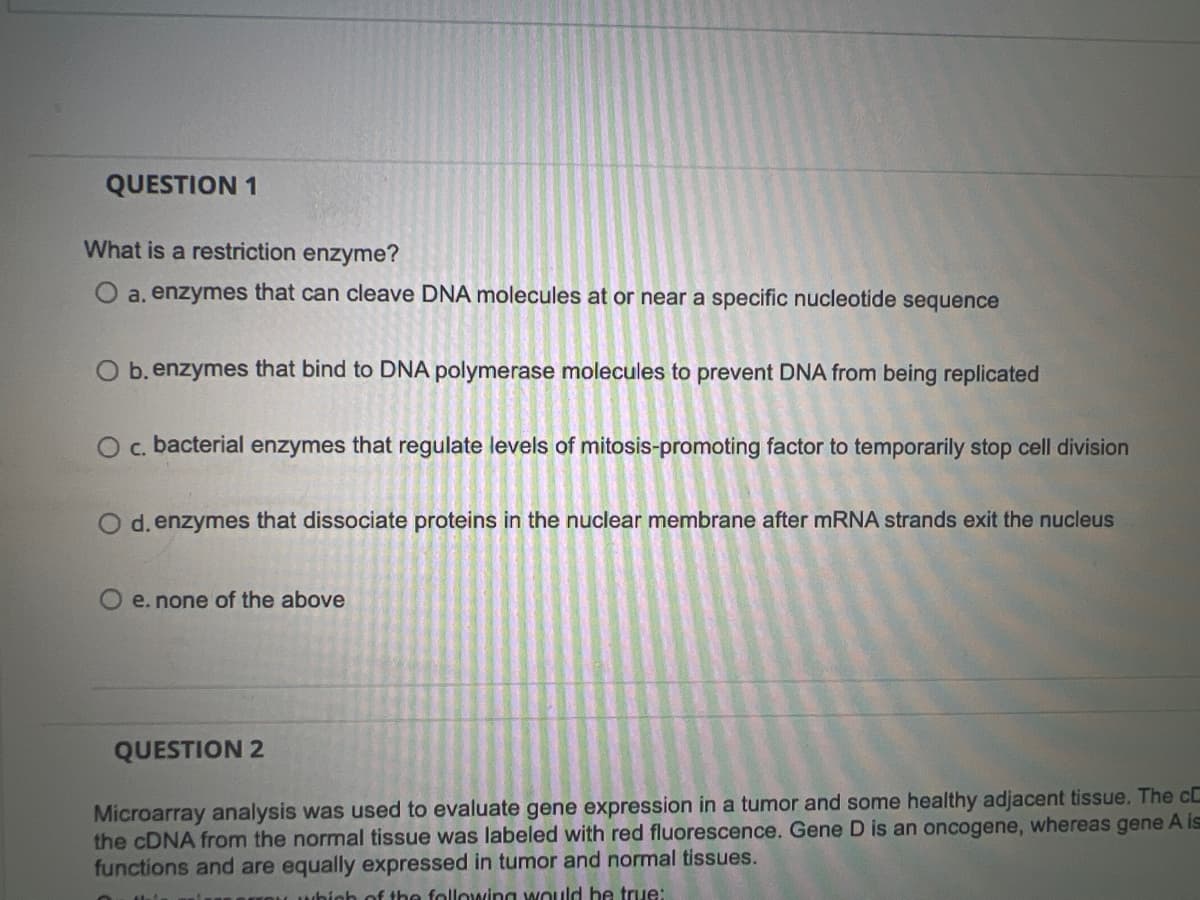QUESTION 1 What is a restriction enzyme? O a. enzymes that can cleave DNA molecules at or near a specific nucleotide sequence b. enzymes that bind to DNA polymerase molecules to prevent DNA from being replicated O c. bacterial enzymes that regulate levels of mitosis-promoting factor to temporarily stop cell division O d. enzymes that dissociate proteins in the nuclear membrane after mRNA strands exit the nucleus e. none of the above
QUESTION 1 What is a restriction enzyme? O a. enzymes that can cleave DNA molecules at or near a specific nucleotide sequence b. enzymes that bind to DNA polymerase molecules to prevent DNA from being replicated O c. bacterial enzymes that regulate levels of mitosis-promoting factor to temporarily stop cell division O d. enzymes that dissociate proteins in the nuclear membrane after mRNA strands exit the nucleus e. none of the above
Human Anatomy & Physiology (11th Edition)
11th Edition
ISBN:9780134580999
Author:Elaine N. Marieb, Katja N. Hoehn
Publisher:Elaine N. Marieb, Katja N. Hoehn
Chapter1: The Human Body: An Orientation
Section: Chapter Questions
Problem 1RQ: The correct sequence of levels forming the structural hierarchy is A. (a) organ, organ system,...
Related questions
Topic Video
Question
1

Transcribed Image Text:QUESTION 1
What is a restriction enzyme?
O a. enzymes that can cleave DNA molecules at or near a specific nucleotide sequence
O b. enzymes that bind to DNA polymerase molecules to prevent DNA from being replicated
O c. bacterial enzymes that regulate levels of mitosis-promoting factor to temporarily stop cell division
O d. enzymes that dissociate proteins in the nuclear membrane after mRNA strands exit the nucleus
e. none of the above
QUESTION 2
Microarray analysis was used to evaluate gene expression in a tumor and some healthy adjacent tissue. The c
the cDNA from the normal tissue was labeled with red fluorescence. Gene D is an oncogene, whereas gene A is
functions and are equally expressed in tumor and normal tissues.
which of the following would be true:
Expert Solution
This question has been solved!
Explore an expertly crafted, step-by-step solution for a thorough understanding of key concepts.
This is a popular solution!
Trending now
This is a popular solution!
Step by step
Solved in 2 steps

Knowledge Booster
Learn more about
Need a deep-dive on the concept behind this application? Look no further. Learn more about this topic, biology and related others by exploring similar questions and additional content below.Recommended textbooks for you

Human Anatomy & Physiology (11th Edition)
Biology
ISBN:
9780134580999
Author:
Elaine N. Marieb, Katja N. Hoehn
Publisher:
PEARSON

Biology 2e
Biology
ISBN:
9781947172517
Author:
Matthew Douglas, Jung Choi, Mary Ann Clark
Publisher:
OpenStax

Anatomy & Physiology
Biology
ISBN:
9781259398629
Author:
McKinley, Michael P., O'loughlin, Valerie Dean, Bidle, Theresa Stouter
Publisher:
Mcgraw Hill Education,

Human Anatomy & Physiology (11th Edition)
Biology
ISBN:
9780134580999
Author:
Elaine N. Marieb, Katja N. Hoehn
Publisher:
PEARSON

Biology 2e
Biology
ISBN:
9781947172517
Author:
Matthew Douglas, Jung Choi, Mary Ann Clark
Publisher:
OpenStax

Anatomy & Physiology
Biology
ISBN:
9781259398629
Author:
McKinley, Michael P., O'loughlin, Valerie Dean, Bidle, Theresa Stouter
Publisher:
Mcgraw Hill Education,

Molecular Biology of the Cell (Sixth Edition)
Biology
ISBN:
9780815344322
Author:
Bruce Alberts, Alexander D. Johnson, Julian Lewis, David Morgan, Martin Raff, Keith Roberts, Peter Walter
Publisher:
W. W. Norton & Company

Laboratory Manual For Human Anatomy & Physiology
Biology
ISBN:
9781260159363
Author:
Martin, Terry R., Prentice-craver, Cynthia
Publisher:
McGraw-Hill Publishing Co.

Inquiry Into Life (16th Edition)
Biology
ISBN:
9781260231700
Author:
Sylvia S. Mader, Michael Windelspecht
Publisher:
McGraw Hill Education